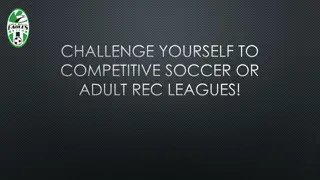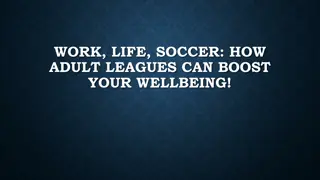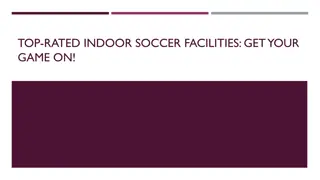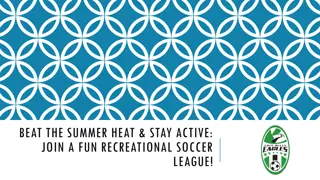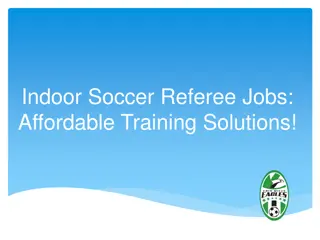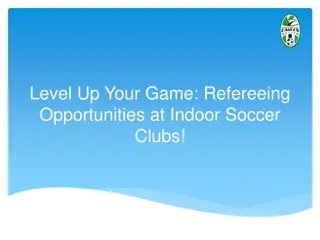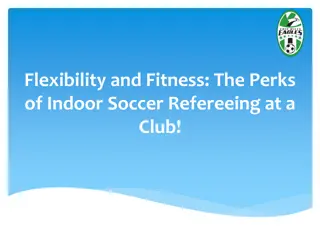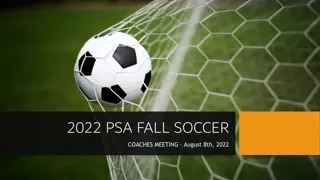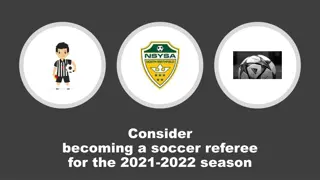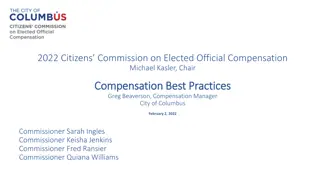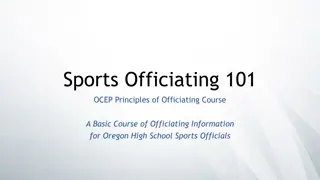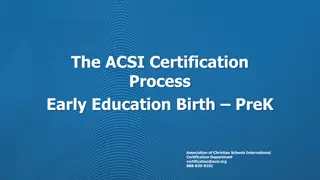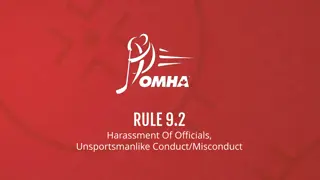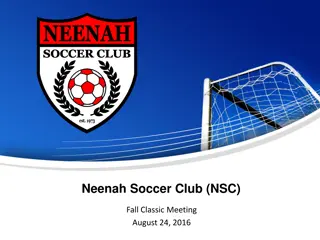OSAA Soccer Officials Certification Process Overview
This presentation provides a comprehensive overview of the certification process for OSAA soccer officials. It covers registration requirements, exam details, certification levels, and additional certifications needed for sub-varsity, varsity, and playoff officiating. The importance of completing online courses and examinations for maintaining eligibility to officiate OSAA-sanctioned soccer contests is emphasized.
Download Presentation

Please find below an Image/Link to download the presentation.
The content on the website is provided AS IS for your information and personal use only. It may not be sold, licensed, or shared on other websites without obtaining consent from the author.If you encounter any issues during the download, it is possible that the publisher has removed the file from their server.
You are allowed to download the files provided on this website for personal or commercial use, subject to the condition that they are used lawfully. All files are the property of their respective owners.
The content on the website is provided AS IS for your information and personal use only. It may not be sold, licensed, or shared on other websites without obtaining consent from the author.
E N D
Presentation Transcript
2021-22 Pre-Season OSAA Soccer Presentation Annual NFHS Soccer Rules Review and OSAA Information for Officials 1
Contact Information Kris Welch, CMAA, CIC OSAA Assistant Executive Director krisw@osaa.org (503) 682 6722 x230 Patrick Duffy OSAA Soccer State Rules Interpreter soccer.sri@osaa.org www.osaa.org/officials 2
Presentation Overview OSAA Officials Certification NFHS Soccer Changes for 2021-22 NFHS/IFAB Comparison OSAA Rule Interpretations Points of Emphasis DOGSO Misconduct 3
OSAA Officials Certification Brief Overview of OSAA Athletic Officials Handbook (AOH) and Annual Certification Requirements for OSAA Soccer Officials 4
Prior to Taking the Field In order to officiate any level of OSAA sanctioned soccer contest (including jamborees), officials must complete the following four (4) items every year: Register with the OSAA, Pass a criminal conviction history screening, Complete the online OSAA concussion course, and Take the online OSAA Soccer Rules exam 50 questions Exam scores determine the level of certification 5
Sub-Varsity Registered as an OSAA Soccer official and passed a background check Completed the annual online OSAA concussion course Completed the OSAA Soccer Rules exam, answered all 50 questions Varsity Met the requirements of a sub-varsity official Scored at least 75% on the OSAA Soccer Rules exam ( 38 correct out of 50) Playoff Met the requirements of a varsity official Scored at least 90% on the OSAA Soccer Rules exam ( 45 correct out of 50) Has OCEP Principles certification Has OCEP Soccer Playoff certification Completed the USSF Grassroots Referee Course at one point in the past Completed this year s OCEP Soccer Playoff Certification Training Course (either offered by your association or completed online; available in early October) 6
OCEP Principles Officials must obtain OCEP Principles certification within the first 3 years of officiating Certification can be obtained in two ways: Attending an OAOA approved OCEP Principles clinic hosted by an association, or Completing the online NFHS Interscholastic Officiating Course www.osaa.org/officials/ocep 7
OCEP Soccer Playoff To officiate any OSAA Soccer State Championship event, officials must have obtained and be currently certified in OCEP Soccer Playoff certification Initially obtained by completing the USSF Grassroots Referee Course Annually complete the current year s OCEP Soccer Playoff Certification Training Course Released in early October Clinic can be hosted by your local association, or Online training course can be completed individually www.osaa.org/officials/ocep 8
NFHS Soccer Changes for 2021-22 Review of NFHS Soccer Rules Changes and Editorial Changes 9
NFHS Rules App Rules App features: Searchable Highlight notes Bookmarks Quizzes for all sports Easy navigation Immediate availability Free to paid members of the NFHS Officials Association www.osaa.org/officials/rules 10
2021-22 NFHS Soccer Rule Changes Rule 4, Player Equipment Rule 13, Free Kick How Taken (editorial change) Changes in the rules book are highlighted In this presentation: blue, underscored red, struckout new wording that was added old wording that was removed 11
Rule 4-2-10, Other Equipment Head coverings worn for religious reasons shall not be made of abrasive or hard materials, and they must fit securely. Head coverings are not considered to be hair devices. 12 Legal Legal
Other Equipment Worn on the Head Players shall not wear illegal equipment; including any equipment deemed dangerous or confusing in the opinion of the referee [4-2-1] Types of ILLEGAL equipment worn on the head include: Head pads made of hard or unyielding material (sole leather, metal, etc.) Spectacle guards (prescription glasses are legal) Sport eyewear that is durable and lies flat to the face is legal [4-2-1 Situation G] Hats, caps, or visors EXCEPTION: The goalkeeper may wear a soft-billed baseball type hat or soft- billed visor. OSAA allows players to wear soft and yielding caps during inclement weather (this include beanies); caps/beanies must be alike in color. Bandannas and doo rags are prohibited [4-2-2 Situation D & 4-2-10 Situation] Hair beads are dangerous and not allowed [4-2-2 Situation D] 13
Other Equipment Worn on the Head Hair control devices may be worn on the head if made of soft material and do not pose risk of injury so long as the item is not worn for adornment [4-2-2, 3] Wearing knotted pre-wrap to control hair is legal There are no color restrictions to hair control devices Jewelry worn on the head, ears, or face are not legal and cannot be taped [4-2-4] Hearing aides and cochlear implants are legal provide the device does not create the threat of injury [4-2-6] A protective face mask is legal and can be made of hard material if it is molded to the face and the player has a medical release [4-2-8] Objectionable face paintings are not legal [4-2-1 Situation B] 14
Other Equipment Worn on the Head Soft-padded headgear is permitted [4-2-9] Sweatbands are legal This includes bandages to cover a head wound There are no color restrictions A medical release is not required Head coverings worn for religious reasons are permitted [4-2-10] OSAA permission is not required, there are no color restrictions Any other types of head coverings may only be worn if the player has a permission letter from the OSAA [4-2-11] For example, if a licensed physician requires a player to wear a covering or wrap on the head, so long as the covering is not abrasive, hard, or dangerous to any other player and the covering is securely attached 15
13-3-2, Free Kick How Taken The ball shall be kicked while it is stationary on the ground at the spot specified by the official. To be in play, the ball shall be moved in any direction. Failure to kick the ball as specified shall result in a rekick. The ball is in play when it is kicked and moves. 16
Previous Rule Changes Play is stopped and restarted with a drop ball if the ball touches an official, stays on the field, and: A team starts a promising attack, The ball goes directly into the goal, or Team possession changes If play is stopped for an injury or any unusual situation (i.e., a deflated ball), then play is always restarted with a drop ball For a drop ball restart, the ball is dropped to a single player of the team last in possession or who last touched the ball or for the goalkeeper if the ball was in the penalty area when play was stopped On a drop ball, all other players must be at least 4 yards away 17
Previous Rule Changes The away team must wear solid white jerseys and socks, the home team must wear a different color of jersey and sock Players are no longer required to tuck in their jerseys Goal kicks and free kicks within the penalty area for the defending team are in play once the ball is kicked and moves in any direction; opponents must be outside the penalty area until the ball is in play During a penalty kick, the goalkeeper must stand with at least one foot on, or in line with, the goal line until the ball is kicked The clock is stopped when a substitute by the team in the lead is beckoned onto the field in the final five minutes of the match If an eight (8) goal differential occurs at halftime or anytime thereafter, the match shall be terminated and considered a completed match [OSAA] 18
NFHS/IFAB Comparison Comparison of the Main Differences Between NFHS Soccer Rules and IFAB Laws of the Game 19
The Field NFHS Rules IFAB Laws of the Game 100 120 yards long 100 130 yards long 55 80 yards wide 50 100 yards wide Before the game, host school administrator determines if the filed conditions are safe for the game to be played or not; once the game begins, it s up to the referee Different dimensions for international matches Determining if the pitch is playable is the responsibility of the referee before and during the match Ball holders are not required in Oregon, if present, there must be at least 2 Allowance for VAR and goal-line technology Ball holders are not required 20
Substitutions NFHS Rules Unlimited number of substitutions IFAB Laws of the Game Limited number of substitutions Re-entry is permitted No re-entry (can be modified for youth competitions) Substitutions only occur during legal substitution opportunities Substitutions occur during any stoppage of play with the referee s permission Player being replaced can leave the field anywhere Player being replaced must leave at the nearest boundary line Substitute becomes a player once then referee beckons them onto the field Substitute becomes a player once they enter the field The clock is stopped if the winning team substitutes with less than 5 minutes left in the game Time is added for substitutions 21
NFHS Legal Substitution Opportunities Stoppage Team Limit From Half-Time Either Team Unlimited Bench, Unbeckoned After a Goal, Injuries Goal Kicks, Cautions, Disqualifications, Blood Concern The Cautioned Player, The Player with Blood Own Throw-In, Own Corner Kick Other Team s Throw-In, Other Team s Corner Kick Either Team Unlimited Bench, then Check In Either Team Unlimited Checked In Before the Stoppage Specific Team Specific Individual Bench, then Check In Team In Possession Unlimited Checked In Before the Stoppage Team Not In Possession Checked In Before the Stoppage & The Other Team Has Subs Unlimited 22
Player Equipment NFHS Rules IFAB Laws of the Game Visiting team must wear solid white shirts & socks There are no color restrictions for teams other than they must be different colors Home team must contrast with white (gray must be 70% or darker) Undershirts must be the same color or pattern matching the shirt sleeve Visible apparel, if worn under the shirt or shorts, must be a single, solid color Undershorts or tights must be the same color as the shorts or bottom of the shorts Players of the same team must wear the same color Players of the same team must wear the same color of undershorts Visible apparel must be the same length of sleeve or leg for the individual 23
Illegal Equipment NFHS Rules Head coach must verify their players are legally and properly equipped IFAB Laws of the Game For any offence of player equipment, if not immediately correctable, the player is removed from the field of play The head coach is cautioned for the first offence of a player wearing illegal equipment Player may re-enter the field with permission from the referee during play or at a stoppage For subsequent offences of illegal equipment, the player is cautioned In all cases, the illegally equipped player must leave the field of play Player may only return at the next legal substitution opportunity for their team 24
Officials & Mechanics NFHS Rules IFAB Laws of the Game Dual or diagonal systems of officiating are allowed Only the diagonal system of control is permissible Two additional signals: timeout/stop clock and wind-up to start clock Time counts up to 90 minutes, only stopped at half-time interval Stoppage time is added at the end of each half by the referee for lost playing time Misconduct reasons are communicated to both coaches Time counts down from 40 minutes in each half, stopping in specific situations The referee keeps time Stadium clock is official 25
NFHS Situations to Stop the Clock Injuries Penalty Kicks Cautions Disqualifications After a Goal During the Game s Final 5 Minutes If the Winning Team Is Substituting Whenever the Referee Decides To Stop the Clock 26
Stopping for Serious Injuries NFHS Rules IFAB Laws of the Game The clock is stopped Injured players must leave and cannot re-enter until after the restart, except: Injured players must leave the field of play, including goalkeepers Goalkeepers Special handling with suspected concussions Goalkeeper & an Opponent Multiple Team-Mates Injury via Opponent s Misconduct Identified Kicker of a Penalty Kick If play is stopped for an injury, then the restart is a drop ball 27
Fouls NFHS Rules Fouls are only committed on the field of play IFAB Laws of the Game Fouls can be committed outside the field of play Reflexive/accidental movements of the hands/arms for protection is not an offense The hand/arm moving to the ball, even if accidental, can be a handball offense Handling considerations do not include the result/impact of accidental/non-deliberate contact with the hand/arm A goal cannot be scored if the ball touches the hand/arm, even if accidental; the outcome after handling is a consideration Charging the goalkeeper in possession of the ball, charging an opponent not within playing distance of the ball, and obstruction are all indirect free kick fouls Fouls involving physical contact (e.g. charging and impeding with contact) are direct free kick fouls 28
Misconduct NFHS Rules Incidental and undirected use of vulgar or profane language is a caution IFAB Laws of the Game Cautioned players do not have to leave the field There are various, subtle differences between caution and send-off offences between IFAB and NFHS Cautioned players must be removed from the field and can be replaced Taunting is a disqualification Sent-off players must leave the technical area (may be modified for youth) Entering the field during a fight is a disqualification If a player is sent-off during halftime, their team plays short- sided Disqualified players can remain in the team area If a player is disqualified during halftime, their team does not play shorthanded 29
Drop Ball & Free Kicks NFHS Rules IFAB Laws of the Game A drop ball is dropped for a single player or goalkeeper and all other players must be at least 4 yards away A dropped ball is dropped for a single player or goalkeeper and all other players must be at least 4 yards away Attackers that encroach closer than 1 yard from a defensive wall of 3+ defending players shall be cautioned and the original kick is retaken Attackers that encroach closer than 1 yard from a defensive wall of 3+ defending players are not cautioned and the defending team is awarded an indirect free kick Restart locations differ when offences occur outside the field of play Physical contact outside the field of play can result in a penalty kick depending on the location 30
Throw-In & Goal Kick NFHS Rules IFAB Laws of the Game Any failure to property perform a throw-in restart results in the throw-in being awarded to the opposing team If the ball does not enter the field of play, the throw-in is retaken For any other offence of the throw-in procedure, the throw-in is taken by a player of the opposing team Players cannot use trickery to circumvent the goalkeeper restrictions of handling the ball (i.e., flicking the ball from the foot to one s head for the goalkeeper to catch with their hands) should not be allowed on a throw-in or goal kick Initiating a deliberate trick for the ball to be handled by the goalkeeper from a goal kick (or a free kick within their own penalty area) is an indirect free kick and is a cautionable offense 31
OSAA Rule Interpretations Review of OSAA Rule Interpretations and Clarifications to Be Enforced During OSAA Sanctioned Contests 32
OSAA Sanctioned Competitions The 2021-22 NFHS Soccer Rules Book will be used in OSAA sanctioned competitions with specific interpretations and clarifications to be implemented in all OSAA inter-scholastic soccer games OSAA modifications can be found in the 2021-22 OSAA ADOPTED SOCCER RULES INTERPRETATIONS available on the OSAA Soccer Central Hub on ArbiterSports and these interpretations were also included in officials packets osaasoccer.arbitersports.com Officials should also be familiar with policies established in the 2021-22 OSAA ATHLETIC OFFICIALS HANDBOOK available on the OSAA website www.osaa.org/officials Referees are not to interpret other OSAA rules beyond these specified above and in subsequent slides 33
The Field of Play If a field is, or appears to be, larger or smaller than the dimensions specified: The referee will bring that to the attention of the game-site administrator The referee will include that information on the game report The contest will still be played Both teams shall be on the same side of the field 34
Players Teams cannot share players A team playing shorthanded cannot use a player from the opposing team Officials are not to interpret OSAA rules regarding participant eligibility, contest limitations, ejection suspension periods, etc. If a concern exists beyond the NFHS rules and OSAA adopted interpretations, the game shall be played with any participant listed by the teams and the official shall include that information on the game report For example, if a visiting coach complains that a home team player should not be allowed to play in the varsity game because they participated in both halves of the previous sub-varsity game, the referee is to allow the player to participate and include details of the issue on the game report 35
Concussion Management for Officials Referees need to be mindful of concussions and treat them as serious brain injuries, suspicion of a concussion should follow: An observed or suspected blow to the head or body, and A player exhibiting signs, symptoms, or behaviors consistent with a concussion Referees shall remove from the game any player with a suspected concussion Document and notify the head coach Be clear that the player is being removed for suspicion of a concussion as opposed to behavior, a non-concussive injury, or other reason Officials are not responsible for evaluation or management of players after they are removed from play 36
Written permission is not needed for a player to return, nor does the official need to verify the credentials of the qualified health care professional who has cleared the player to return Include on your game report any incidents of a suspected concussion and if a player returns to the game after a suspected concussion 37
Player Equipment A tooth and mouth protector is not required Players may wear soft and yielding caps (or beanies) during inclement weather Caps must be alike in color It is recommended that team captains wear an upper arm band; the captain s band, if worn, must be worn on the upper-arm It is recommended that substitutes wear distinguishable pinnies When an illegally uniformed team is unable to correct the situation or cannot verify OSAA approval of their uniforms, the game shall be played with no sanctions for misconduct The referee should record the situation and include the details on the game report 38
Jewelry Jewelry shall not be worn by any player, even if taped (tape does not make jewelry legal) A religious medal or other item is permitted if taped to the body and worn under the uniform Medical alert items are permitted and must be taped to the body and may remain visible Illegal jewelry includes: earrings, nose rings, studs, spacers, gauges, Daith piercings, necklaces, bracelets (metal, plastic, beads, leather, tape, string), watches, etc. 39
Hair Control Hair-control devices may be worn if made of soft material and not for adornment Sweatbands and/or hair-control devices may be worn on the head or wrist if made of soft material and do not pose risk to injury There are no color restrictions for sweatbands or hair-control devices Cannot be worn for adornment 40
ILLEGAL LEGAL 41
Soft-Padded Headgear Soft-padded headgear is permitted No medical release is required LEGAL LEGAL LEGAL 42
Religious Head Coverings Head coverings worn for religious reasons are legal No OSAA authorization letter is required Legal Legal 43
Officials Recommendation for Equipment Be sure to ask each head coach if their players are legally and properly equipped before the game Inspect player uniforms and equipment before the game This is preventive officiating Inspections should be informal (no lining up of players is necessary) Referees should be diligent about uniforms from the start of the season through playoffs Shirt color rules only apply to varsity games For sub-varsity levels, shirts just have to contrast with each other 44
Systems of Officiating Only the dual or diagonal systems of officiating may be used Athletic districts may select one of these systems for regular season league contests; otherwise, its up to the commissioner of officials The jurisdiction of the officials begins when they enter the field and its immediate surroundings (for example, entering the stadium) Jurisdiction ends when they leave the field and its immediate surroundings at the end of the game After the game, officials do not need to verify scores with the teams, but should ensure the crew collectively has the correct score After the game, the officials should immediately leave the field and its immediate surroundings 45
Officials Uniform & Equipment The jersey for officials shall be the same as that approved for officials by the United States Soccer Federation Crews must match in jersey color, but do not have to match sleeve length Officials may use electronic communication equipment (beeper flags, radio comm. systems, electric whistles, etc.) Officials may use a colored whistle in recognition of charitable causes During the month of October, soccer officials may wear pink colored jerseys in recognition of Breast Cancer Awareness Month Entire crew must match in color 46
Pre-Game Meetings Although NFHS rule 5-2-2-d calls for a single meeting between officials, captains, and head coaches, such a meeting is not required in Oregon Referees must obtain a complete roster and inquire of each head coach whether their players are properly and legally equipped before the game A separate meeting then takes place with officials and captains to discuss sportsmanship and conduct the coin toss as provided in 5-2-2-d-2 & 3 47
Ball Holders, Timer, and Scorer Ball holders are optional, but are highly recommended If provided, there shall be at least two ball holders The head referee shall be the official scorekeeper If a timer or visible timing device is not available, or the timer continually fails to start/stop the clock appropriately, or the visible timing device malfunctions, then time shall be kept by the head referee; in this case, Continue to use the approved timing signals No visible clock is to be used The scoreboard would still be allowed to show the score For example, the home team wants to use the stadium clock without an operator and stop the clock in under five minutes left in each half. This would not be allowed. Time would be kept by the head referee and the stadium clock would not be used to display the game time at any point. 48
Game Duration The duration of the game shall be two equal halves of 40 minutes each, even for sub-varsity games No overtime is allowed during pre-season or regular season matches (no overtimes and no kicks from the penalty mark) Matches that are tied at the end of regulation time will be considered a draw OSAA State Championship tie-breaking procedures shall be used in all district playoffs, play-ins, OSAA playoffs, and championship matches If an 8-goal differential occurs at halftime or anytime thereafter, the match shall be terminated and considered a completed match 49
Ejected Player or Coach All red cards/disqualifications/ejections must be reported by officials Ejected coaches must leave the game immediately and shall remain out of sight and sound Delay the restart until the coach is out of sight and sound Officials should record pertinent information and include those details on the game report Ejected players may remain in the team area If a coach is ejected and is the only adult on the roster: The referee should allow the ejected head coach to name a replacement adult before leaving sight and sound The replacement adult must be added to the roster This information would be included on the game report 50




